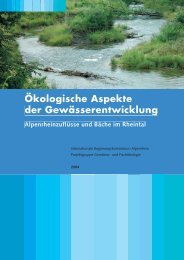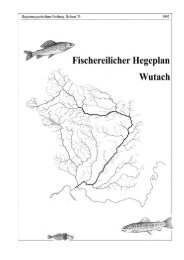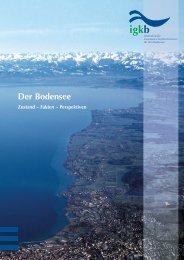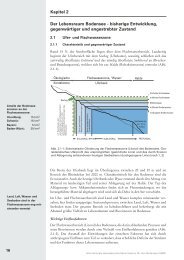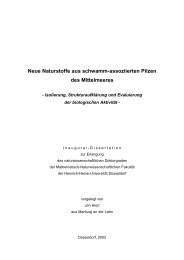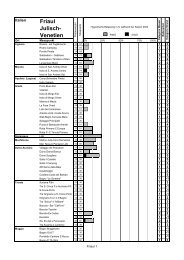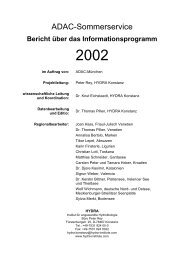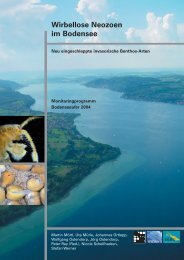marine microbial thiotrophic ectosymbioses - HYDRA-Institute
marine microbial thiotrophic ectosymbioses - HYDRA-Institute
marine microbial thiotrophic ectosymbioses - HYDRA-Institute
Create successful ePaper yourself
Turn your PDF publications into a flip-book with our unique Google optimized e-Paper software.
2727_C04.fm Page 106 Wednesday, June 30, 2004 12:00 PM<br />
106 J. Ott, M. Bright & S. Bulgheresi<br />
An 8-mm-long Stilbonema majum with a diameter of 60 mm covered by a mucus sheath of 7.5<br />
mm thickness and containing 10 layers of 1.3 ¥ 0.6 mm cocci carries about 21 ¥ 10 6 bacteria. This<br />
makes up 22% of the volume of the symbiotic consortium. In Laxus oneistus the density of the<br />
upright rods is approximately 3.5 cells mm –2 . A 9-mm-long male with a diameter of 50 mm and an<br />
8-mm-long bacterial coat is covered by 4.5 ¥ 10 6 rods (size 2.1 ¥ 0.6 mm each). This represents<br />
12.3% of the consortium volume.<br />
In the genus Eubostrichus, two types of arrangement of the bacteria are found: in E. parasitiferus<br />
and several similar undescribed species the bacteria are crescent-shaped nonseptate filaments, 0.6<br />
¥ 30 mm in size, that are attached to the cuticle with both ends oriented parallel to the worm’s<br />
longitudinal axis. About 80 bacteria are arranged in a spiral fashion around the circumference of<br />
each worm, giving it the appearance of a rope. In cross section the bacteria appear to form several<br />
layers, when, in fact, all bacteria are in contact with the worm surface. A 3-mm-long E. parasitiferus<br />
with a diameter of 20 mm carries about 8000 bacteria, which make up only 7% of the volume of<br />
the symbiotic consortium, despite their spectacular appearance. In E. dianae the bacteria form up<br />
to 120-mm-long and 0.4-mm-thick filaments, which are attached to the cuticle by one end (Figure<br />
6) and form a dense fur-like coat that in live worms appears nicely groomed. With a size similar<br />
to that of E. parasitiferus, E. dianae carries 40–60 ¥ 10 3 filaments, contributing substantially<br />
(36–44%) to the consortium volume. The dense <strong>microbial</strong> coat is colonised by additional bacterial<br />
epibionts (Polz et al. 1999a).<br />
Rimicaris<br />
Three morphological types of bacteria have been described from Rimicaris by various authors (Van<br />
Dover et al. 1988, Casanova et al. 1993, Gebruk et al. 1993, Polz & Cavanaugh 1995): rods with<br />
a diameter from 0.2–0.4 mm and 0.5–3 mm in length and two kinds of filaments, a rare form with<br />
a diameter of 0.2–0.5 mm and a common larger form with a diameter of 0.8–3 mm (Figure 14).<br />
Several septate filaments grow from a common basal attachment disc and, in the large form, may<br />
attain a length of 1.5 mm. The filaments consist of cylindrical cells of approximately the same<br />
length as their diameter. These bacteria densely cover the inner surface of the extended carapace<br />
and also cover the bacteriophores on the enlarged exopodites of the second maxilla and first<br />
maxilliped and on the bases of the thoracic appendages. The rods co-occur with the filaments and<br />
are especially abundant in juveniles. They are attached along their whole length to the cuticle of<br />
the shrimp.<br />
Using a 16S rRNA-specific fluorescent hybridisation probe, Polz & Cavanaugh (1995)<br />
demonstrated that all three morphotypes belong to the same phylotype of e-proteobacteria. A<br />
number of parasites, but also sulphur bacteria such as Thiovolum sp., are found among the eproteobacteria.<br />
Recently, bacteria related to Rimicaris symbionts have been detected with<br />
molecular methods in <strong>marine</strong> anoxic water and sediments (Madrid et al. 2001, Lee et al. 2001).<br />
Elemental sulphur within the cells and RuBisCo activity (Gebruk et al. 1993) strongly suggest<br />
a <strong>thiotrophic</strong> nature of the bacteria. Polz & Cavanaugh (1995) estimate that an average shrimp<br />
may carry 8.5 ¥ 10 6 bacteria.<br />
Mutual benefits<br />
The consensus is that the above symbioses are largely nutritional. On one hand, the bacteria provide<br />
organic matter from their own primary chemoautotrophic production. On the other hand, the<br />
eukaryote partner facilitates access to reduced sulphur compounds and electron acceptors, which<br />
may be separated in space and time. Since sulphide is toxic for aerobic metazoans, the idea has<br />
been proposed that the bacteria may act as a detoxification mechanism, oxidising sulphide into<br />
elemental sulphur and finally to sulphate (Somero et al. 1989). Powell (1989) argued that in



